Oil scraper rings and caps are one of the most important components of a car engine. To carry out competent repairs, it is important to know what these parts are, how to find and replace them.
Oil scraper (or piston) rings are considered the most important elements of an internal combustion engine. The entire set usually consists of three types of rings: upper compression, compression-oil scraper and lower oil scraper. All of them are responsible for a large number of parameters. These include: oil and fuel consumption, vehicle power, its starting ability and exhaust toxicity.
Main function piston rings- This is heat removal from the piston. If this does not happen, various defects or even jamming may appear on the piston. In addition, the rings ensure maximum tightness of the combustion chamber: they prevent gases from entering the engine crankcase and minimize the entry of oil into the chamber.

Rings can consist of two or three components. The first include the ring itself and the spring, made in the form of a spiral. Due to this, maximum flexibility of the elements and the tightest fit of the ring are achieved. The structure, consisting of three elements, contains a spacer spring and two plates made of steel. This design makes it possible to achieve maximum tightness along the entire perimeter of the contact of the rings and has found application in gasoline engines.
Operating principle of oil scraper rings
The compression ring experiences the heaviest loads, since it experiences the highest gas pressure and high temperature. Such rings are made of alloy steel, and a wear-resistant coating is applied to their surface.
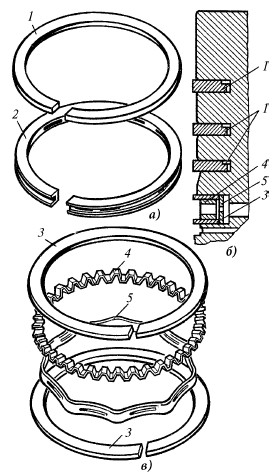
A - appearance, b - arrangement of rings on the piston, c - composite oil scraper ring; 1 - compression ring, 2 - oil scraper ring, 3 - flat steel discs, 4 - axial expander, 5 - radial expander
As the critical point is approached, the amount of oil in the upper part decreases, and the pressure and temperature increase. The speed of movement decreases, and stopping leads to complete rupture of the lubricant film. All this means that the compression ring experiences dry friction, which means it wears out quite quickly.
Compression oil scraper rings are subject to less stress, but perform two functions at once: draining engine oil into the crankcase and maintaining compression in the cylinder. In this regard, they have a conical shape with certain angle tilt
Oil scraper rings experience the least load and are responsible only for draining oil into the engine crankcase. To do this, they are equipped with two belts, between which the remaining oil is collected and through a special edge in the lower part it is discharged into the engine sump.
Checking the condition of the piston rings
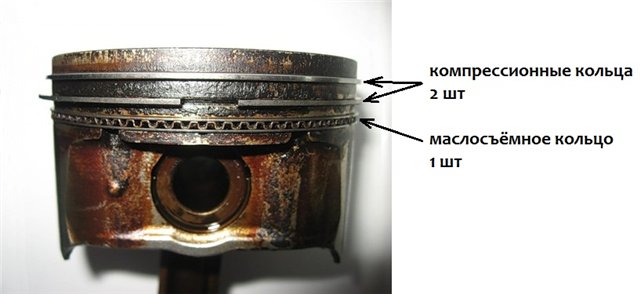
As you already understand, the operating mode of the rings is extremely difficult. This is due to enormous pressure, friction and increased temperature. In this regard, their natural wear occurs, which usually occurs after 150,000 kilometers. However, many drivers claim that their engine withstood 500,000 kilometers. Such results can only be obtained with very correct operation of the car; in other cases, wear of the rings occurs quite early.
Failure of piston rings ahead of schedule usually occurs when using low-quality oil or mixing it with another. It is also important to monitor the condition of the air and fuel filters, especially when driving on a very dusty road. Above all, do not overload or overheat the engine. Carbon formation due to elevated temperatures, promotes the occurrence of rings.
How do you know if your piston rings need repair? To do this, you need to pay attention to oil consumption. Increased lubricant consumption is the very first sign of piston ring failure. Oil enters the combustion chamber and bluish smoke appears from the exhaust pipe.
In addition, the malfunction of the piston rings can be judged by contamination of the spark plugs and oil leakage and evaporation in the places where gaskets and seals are installed.
Decarbonization of piston rings - what is it for?

If carbon deposits are detected, it is not necessary to replace the piston rings. Experienced drivers have long found a proven way to quickly get rid of carbon deposits and bring stuck rings back to life. For this, a special mixture is prepared, which contains kerosene and acetone in equal quantities. The spark plugs are unscrewed and the prepared mixture is poured into the holes. After 9 hours, tighten the spark plugs and start the engine. After this, you need to drive about 15 kilometers at maximum speed. At the end of the procedure, be sure to change the oil and air filter.
In addition to using folk recipes, you can purchase a special oil ring decarbonizer in the store. Its effect is usually limited to 15 minutes.
Raise the part of the car whose wheels are driving (for example, front-wheel drive - the front part is hanging out). Set the last gear, unscrew the spark plugs and turn the wheel until the pistons are in the middle position. For control, you can use the marks located on the flywheel of the crankshaft and block. After this, pour the decarbonizer into the spark plug holes and wait for the time according to the instructions on the label. To achieve a better effect, you can turn the wheel from time to time.
The last step is to crank the engine with a crooked starter in neutral gear. This action is necessary in order to squeeze out the remaining fluid and carbon deposits from the engine. Then screw back the spark plugs and start the engine and let it idle for 15 minutes.
Do not be alarmed if the engine does not start immediately and suspicious smoke appears from the exhaust pipe. All this is absolutely normal.
Replacing piston rings with your own hands - Video
Decarbonization can only help get rid of the appearance of carbon deposits. If the rings are heavily worn, they must be replaced immediately.
When purchasing a new set of rings, give preference only to high-quality parts. Do not be afraid of the high price, since cheap analogues can make the engine work normally for only a few thousand kilometers. Please ensure that the material used to make the rings matches the material of the engine. This is one of the main criteria.
The next step is to drain the oil and remove all components that prevent the pistons from being pulled out of the block. Remove the air filter, fuel pump and unscrew the ignition distributor mounting bolts. Then remove the camshaft gear, unscrew the cylinder head cover and remove it. After this, unscrew the housings securing the camshaft bearings.
As soon as access to the camshaft is opened, it is pulled out along with the oil seal. The part is installed so that the piston is at top dead center. The candle is turned out, and a special rod is inserted into the hole, which will prevent the valve from falling down. Using a special puller, the valve spring is compressed and two crackers are pulled out with tweezers. To pull out the rings, you also need to use a special device.
Installation of new rings is carried out in reverse order, however, before pressing them in, be sure to lubricate them with engine oil. It is extremely important not to mix up the sides, as this may cause increased oil consumption.
Considering the principle of operation of an internal combustion engine, one can understand that the main processes take place in the cylinders. Moreover, this requires the creation of certain conditions, one of which is ensuring the tightness of the combustion chamber - the space located above the piston. Moreover, the piston itself is a moving element that moves inside the cylinder, that is, there is a sliding connection between them.
It is worth noting that the piston diameter must be smaller than the internal dimensions of the cylinder. And all because the processes taking place in the cylinders are accompanied by the release of a significant amount of heat. Due to exposure to high temperatures, metals expand. If the diameter of the piston were equal to the cylinder, then jamming would occur when heated. It turns out that there is a gap between these elements, that is, there will be no tightness. To solve this problem, another element was added to the CPG design - special rings mounted on the pistons.
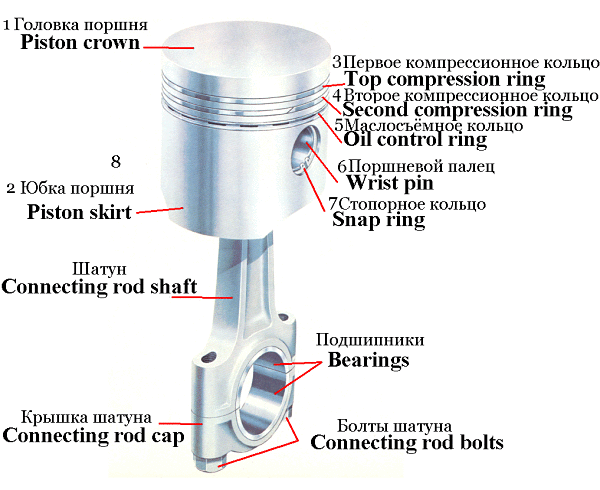
Piston device
These CPG elements have a number of important functions:
- Ensures the tightness of the combustion chamber.
- They regulate the amount of lubricant used to lubricate the cylinder walls, and also prevent it from entering the space above the piston.
- Heat is removed from the piston to the cylinder.
The functioning of piston rings takes place under rather difficult conditions - high temperature exposure, significant mechanical loads arising not only from constant exposure to gases, but also from increased friction due to a lack of lubricant in the area of the piston bottom. 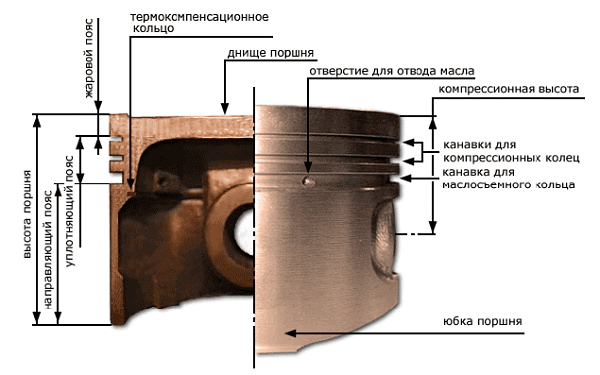
One ring would not cope with the tasks, so several elements are installed on the piston, each of which performs specific functions. All piston rings are divided into two types:
- compression (designed to ensure tightness);
- oil scraper (adjust the amount of lubricant in the CPG).
The total quantity may vary and depends on design features power plant. The most widespread is the three-ring arrangement (2 - compression, 1 - oil scraper). But there are engines in which their number can reach 7 pieces. And for example, on two-stroke engines only two compression valves are installed, and the oil scraper is not used.
All rings used are of the open type. That is, they are not solid (it would simply be impossible to install it in the piston groove), and there is a cutout in it, which, by the way, also plays an important role.
In the expanded state, the rings are made in the shape of an oval, and the distance between the ends is significant. This makes it possible to easily put it on the piston and install it in a special groove in it. When seated in the cylinder, it takes the correct round shape, which ensures a fit around the entire circumference, while the cutout (lock) is reduced, and this gap is only 0.15-0.5 mm. This gap is thermal, and its task is to compensate for dimensions as a result of thermal expansion.
Since there is a gap, gases can pass through it into the sub-piston space. To eliminate this factor, two compression rings are installed. They create a so-called labyrinth-type seal, for which the lock of the first ring is rotated 180 degrees. regarding the second. But even this solution does not ensure complete sealing of the above-piston space and some of the gases penetrate into the crankcase.
Video: ICE Theory: Piston Rings (Part 2)
Let us note that the installation of an additional third compression ring although allows to reduce leaks, but at the same time the friction force in the CPG increases greatly, so this solution is impractical.
Compression rings
The main load falls on the first compression ring, located closest to the piston bottom. Its main task is to ensure the tightness of the combustion chamber. It is the one that experiences the most high-temperature exposure and gas pressure, and all this in conditions of a lack of lubricant. In order to minimize friction between the wall and the ring, the latter’s working surface is made rounded. Also, a molybdenum or chromium insert sprayed onto the surface can reduce the wear of the upper ring when operating under difficult conditions, but it itself is made of elastic high-strength cast iron, but sometimes steel is also used.
Video: 2.0 ICE Theory: Error in installing the oil scraper piston ring
It is noteworthy that the working gases take part in creating the tightness of the combustion chamber. For this purpose, the height of the ring is slightly less than the height of the groove. Through the gap formed, gases penetrate into the groove and begin to put pressure on the inner surface of the ring, further pressing it against the wall.
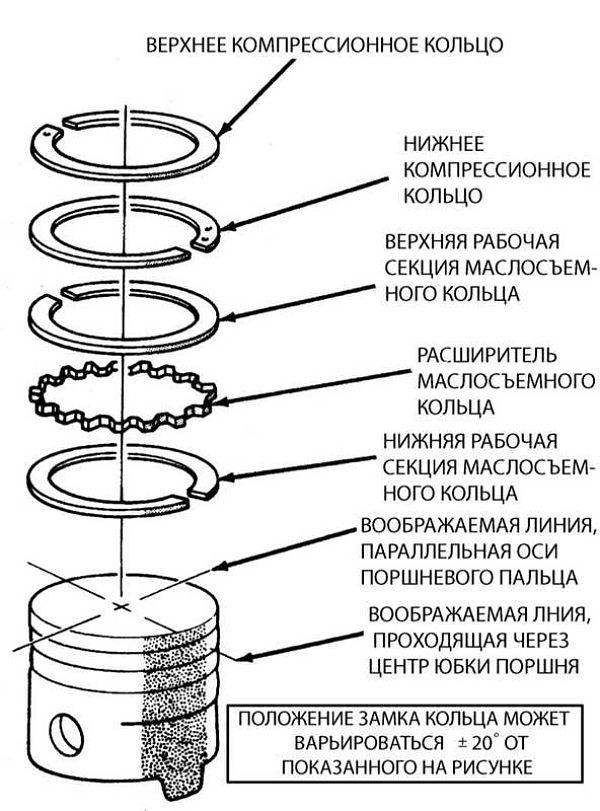
Some manufacturers produce so-called “one-piece” compression rings. In fact, it consists of two flat rings, which, after being seated on the piston, turn 180° relative to each other using locks. In essence, this design makes it possible to complicate the labyrinth seal, thereby reducing the amount of gases passed through.
The second compression ring serves two purposes. Firstly, it is an element of the labyrinth seal and prevents the penetration of gases that have broken through the upper ring into the sub-piston cavity. And secondly, it takes part in adjusting the amount of lubricant on the cylinder walls. This element has a specific working surface shape (conical or L-shaped). This surface plays the role of a scraper, removing excess lubricant from the walls and discharging it to the oil scraper ring. That is why it is also called scraper.
Since it takes significantly less load than the first one, high-strength spraying is not used in its design; it is made entirely of ductile cast iron.
Oil scraper rings
The task of oil scraper rings is to adjust the thickness of the oil film on the cylinder walls, namely adjustment, and not complete removal of the lubricant. If there is not enough oil, the friction force will be increased, which will lead to rapid wear of the rings, as well as the possible appearance of scoring on the cylinder walls. During combustion in the combustion chamber, a large amount of it will settle on all surfaces inside it.
Structurally, this element is the most complex and it is the only one that has drainage holes to drain the removed oil. Two types can be used on cars:
- U-shaped.
- Composite.
The working elements of the U-shaped ring are two edges that scrape the lubricant from the walls. Moreover, the oil removed by the upper edge passes through the drainage holes and flows down through the channels made in the piston. The lubricant scraped off by the lower edge goes down the walls of the piston skirt and cylinder.
Video: We insert pistons into the cylinder block
To ensure the necessary pressure to the surface, special tangential expanders are used:
- spiral;
- lamellar;
These expanders are installed in the piston groove under the ring. For a spiral expander, a special groove is made on the inner surface of the ring.
Composite oil scraper rings are distinguished by a collapsible design that includes several elements, namely two flat annular plates (made of steel and coated with chrome), between which two expanders are placed - tangential and axial. In some cases, only one expander is used, allowing expansion in both directions.
Basic faults

Since these CPG elements are in constant contact with the cylinder wall, their main malfunction is the wear of the working surfaces. The service life of these elements largely depends on the material of manufacture and operating conditions, and it can vary from 150 thousand to 1 million km.
But failure to comply with operating rules can significantly reduce their service life. The resource can be affected by:
- Untimely in the power plant.
- Use of low quality fuel.
- Frequent use of the car in traffic jams or short trips.
- Creating excessively large loads on the power plant.
- Motor overheating.
The main signs of severe wear of the piston rings are a strong drop in compression, as a result of which the power and dynamic performance of the car decrease and fuel consumption increases, as well as a significant increase in lubricant consumption.
Piston rings form a seal between the cylinder wall and the piston. Must provide good sealing across the entire plane of the cylinder over a wide temperature range. In four-stroke engines, three rings are most often used, of which two are compression rings and a lower oil scraper ring.
- Compression rings provide a reliable seal between the cylinder and piston to seal the combustion chamber.
- Heat removal from the piston to the cylinder walls.
- Oil scraper rings remove excess oil from the cylinder walls, preventing it from entering the combustion chamber. However, they are not completely removed, but are adjusted, leaving the required amount of oil for the compression rings.
First compression ring
Designed solely to prevent breakthrough of expanding gases in the combustion chamber. During the power stroke cycle, increasing pressure in the combustion chamber forces the first compression ring to the bottom of the piston groove and presses it harder against the cylinder walls, thereby providing sufficient insulation of the combustion chamber. The pressure in the ring groove is maintained during subsequent strokes.
managing to descend. The gap between the ring and the groove is 0.04-0.08 mm
Protects the second ring from high combustion temperatures and reduces the load. It has the greatest heat transfer from the piston to the cylinder; approximately 50-60% of the heat removed from the piston to the cylinder occurs on the compression rings. Some of the gases break through, the second ring begins to perform its functions, more on that later.
The first compression ring is made of high-grade cast iron, capable of withstanding high temperatures and loads while having a low coefficient of thermal expansion. During engine operation, the ring temperature reaches 180-210°C, at top dead center where there is practically no lubrication due to friction, another high temperature. The outer working surface of the ring often has a special coating to reduce friction. This can be plasma surfacing of molybdenum, cermets, and ceramics. The most common type is chrome coating, which has a matte gray color (applied by electroplating) and a peculiar porous structure that allows it to retain oil to further reduce friction. The remaining surfaces are black as a result of phosphating. The coating provides anti-friction and anti-corrosion properties.
Compression rings are not made entirely round, but have a complex arc shape in the free state and a fairly large end gap. Once the ring is in place in the piston and inserted into the cylinder, it will provide uniform clamping force at any point on the circumference.

Second compression ring
It works in more favorable conditions and performs the function of an additional seal. Also, due to its special shape, it helps the oil scraper remove excess oil, leaving only an oil film on the surface of the cylinder. The average ring temperature is 150 - 170 °C in operating mode. The gap between the ring and the piston groove is slightly lower than the first one 0.03-0.06 mm. The variety of ring shapes determines the performance of certain functions. Such as distributing the load in the groove, reducing friction of the piston skirt by aquaplaning with oil, removing excess oil.

The chamfer on the inside of the ring determines which direction the ring will bend. If the chamfer is on the bottom, then the ring, after heating, will turn its outer surface down, as shown in the picture. And accordingly, if the chamfer is on top, then the working surface of the ring will turn upward.
Oil scraper ring
Under the compression rings there is an oil scraper ring, which performs the function of removing excess oil from the cylinder walls.
A large amount of oil penetrating through the compression rings into the combustion chamber has a bad effect on engine performance. During operation, burning oil is deposited on the valve walls, combustion chamber, spark plugs, and piston bottom. Large deposits become very hot, increasing the likelihood of detonation. Exhaust valves are subject to increased temperature stress.
The thin layer of oil film left by the oil scraper rings reduces the friction force of the compression rings, increasing their durability. Unlike compression oil scrapers, they are not pressed by the operating gas pressure to the plane of the groove in the piston and the cylinder walls, therefore they have special axial and radial expanders.
By design, two types of rings can be distinguished: box-shaped And typesetting both may have different extenders.

As the piston moves downwards, the oil scraper rings scrape excess oil from the cylinder walls and direct it through the drainage holes in the piston back into the crankcase. An oil wedge in front of the ring helps to effectively lubricate the sliding piston skirt. The cylinder walls have a roughness, the so-called hon. which allows you to retain the thinnest layer of oil for compression rings.
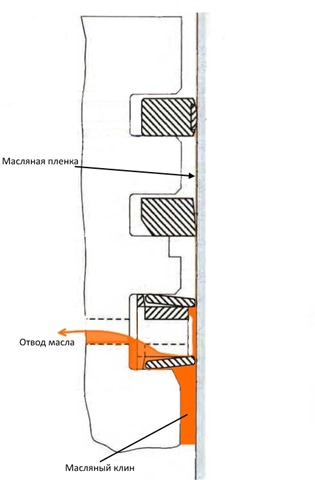
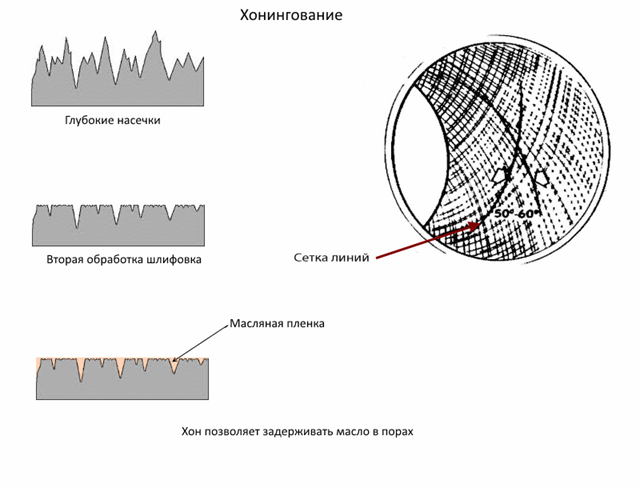
More common are stacked rings consisting of two thin steel plates (often with different coatings to reduce thorns) and a tangential expander that performs both axial and radial expansion. Used in modern engines.
Features of installing oil scraper rings
I would like to draw your attention to the installation of oil scraper rings. There should be no problems with compression if you follow simple rules, install them with the inscriptions facing up (inscriptions, dot) and use a special tool.
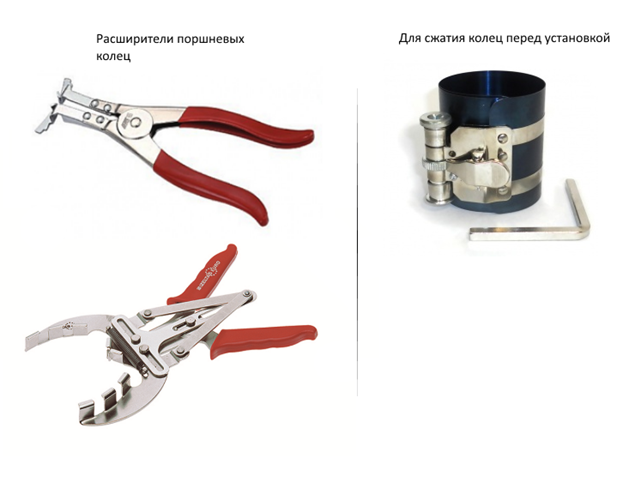
When installing oil scraper valves, difficulties may arise if there are no inscriptions, or if the expander lock is installed correctly. Let's look at this in more detail. If there are no inscriptions, then it does not matter which side you put the ring on and which one will be on top and which one will be on the bottom (inlaid).
Often errors occur when installing the piston into the cylinder, even if a special clamp is used to tighten the rings on the piston. The peculiarity is as follows. When assembling the oil scraper ring, you should pay attention to the expander lock and the correctness of its docking. For clarity, see the image below.
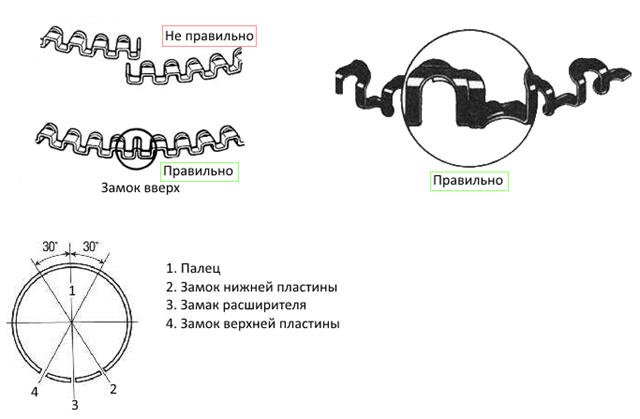
During compression of the rings on the piston, the lock of the oil scraper ring expander can jump out of the correct position and overlap, gathering in a spiral, so the plates fall through the expander and this will lead to scuffing of the cylinder walls and piston grooves. To avoid this, the tightening clamp should be positioned as shown in the image.

By following simple rules, you will correctly install the rings in the cylinder.
When studying the principles of operation of an internal combustion engine, it was noted that the sliding connection between the piston and the cylinder is sealed, that is, gases under pressure in the space above the piston do not penetrate between the piston and the cylinder walls into the engine crankcase. The main purpose of piston rings is to ensure acceptable tightness. It should be noted that a small part of the gases from the combustion chamber still penetrate into the internal space of the crankcase, even of a new, completely serviceable engine. A seal using piston rings is technically called a labyrinth type seal; in seals of this type, some gas leakage always occurs. But this leak on a working engine usually lies in the range of 0.5 - 1.0%.
The gases found in the engine crankcase are called crankcase gases. As the cylinder-piston group of the engine wears out, the amount of crankcase gases increases.
In addition to sealing, piston rings perform two more tasks. They regulate the amount of oil on the cylinder walls necessary to lubricate both the rings themselves and the piston, and remove heat from the piston to the cylinder walls.
Purpose of piston rings:
- Ensuring tightness between the piston and cylinder walls.
- Regulating the amount of oil needed to lubricate the piston-cylinder connection and prevent oil from entering the engine combustion chamber.
- Heat removal from the piston to the cylinder walls.
The piston rings perform these three tasks under very difficult conditions under the influence of high thermal and mechanical loads. Thermal stress of the piston rings occurs under the influence of hot working gases and under the influence of friction of the rings against the cylinder walls, which occurs under conditions of oil starvation in the upper part of the piston.
The successful solution of these problems is achieved both through the design of the rings and the correct selection of the material for making the rings.
Ring type
Piston rings - diagram
1.1. Molybdenum anti-wear insert
- Second compression ring
- Oil scraper ring
3.1. Upper oil scraper plate
3.2. Tangential expander
3.3. Lower oil scraper plate
A photograph of a cross-section of a modern gasoline engine piston with a typical set of piston rings installed on it in accordance with the diagram given in the top picture.
Compression rings provide the necessary tightness, and oil scraper rings regulate the amount of oil on the cylinder walls. It is precisely this that is adjusted, and not completely removed, since complete or too much oil removal will lead to oil starvation of the connection of the piston with the cylinder walls in the upper part of the piston and subsequent jamming of the piston in the cylinder.
Previously, engines were low-speed, and the number of piston rings on one piston reached 5 - 7. But almost all modern gasoline engines and high-speed automobiles diesel engines They have only three piston rings on one piston - two compression rings and one oil scraper ring.
Although the pistons of engines of forced sports cars, constantly operating at high speeds, may have only two rings. And the pistons of diesel car engines, to facilitate starting, may have four rings, three of which are compression rings.
Some terminology
- End clearance in free state
- End clearance in compressed state
- Torsion twist of the ring after compression
Compression piston rings
First (upper) compression ring
The ring installed in the groove of the piston located in the engine cylinder must take on an absolutely round shape (this is done if the cylinder liner itself has no deformations) and be pressed against the surface of the cylinder along the entire outer circumference of the piston ring. To ensure this, the elastic piston ring is made not in the form of a regular circle, but in the form of an arc of variable radius, larger than the diameter of the cylinder and having a sufficiently large gap (1) between the ends of the ring in the free state. When installed in the cylinder, the ring is compressed and the gap (2) in the ring lock becomes 0,15 ? 0,5 mm. The exact and maximum permissible value of this gap is indicated in the technical documentation of the engine. Ensuring a regulated gap value is very important; an increased gap contributes to the breakthrough of gases into the engine crankcase and a decrease in power. But even more dangerous is the reduced clearance in the piston ring lock. During operation, as a result of heating, the ring expands and with a reduced gap, jamming of the piston ring in the cylinder may occur, which will lead to the formation of scuffing on the cylinder surface, breakage of the inter-ring partitions of the piston, or breakage of the ring itself. Therefore, a slight increase in the gap is acceptable, but a decrease in the gap in the piston ring lock is unacceptable.
Leading manufacturers of piston rings produce rings with a gap that gradually decreases after 0.1 mm; there can be up to 15 such selected sizes.
No end clearance while reducing ring height
Some piston ring manufacturers produce "no clearance" piston rings. Of course, it is impossible to change the natural property of metals to expand with increasing temperature; a ring installed in an engine cylinder without clearance will certainly jam. But a lot can be solved through a successful design. In this case, the piston ring consists of two flat rings installed on top of each other and rotated 180° relative to each other. In this case, the upper ring has the shape of the letter “ L ", and the lower ring is inserted into the recess of the upper ring, due to which the height of such a ring is no more than the height of a standard ring.
Once upon a time, the piston ring locks of old low-speed engines had a complex shape to reduce gas breakthrough through the ring lock, but in modern high-speed engines, gas breakthrough through the ring lock is insignificant. Therefore, modern rings have only a rectangular lock shape.
Piston ring locks
Correct installation of piston rings
The variable arc radius of the piston ring is not taken arbitrarily, but is calculated to provide the necessary diagram of the force of pressing the ring against the cylinder walls. During operation, the piston ring wears unevenly. As a result of experiments, it was determined that the ring wears out most intensively in the area of the lock. Therefore, the initial increase in the ring pressing force in the lock area increases the service life of the ring.
But the precisely calculated ring force diagram can change as a result of unprofessional installation of the ring on the piston. Modern, very thin compression piston rings must not be installed on the piston by hand. To do this, it is necessary to use a special device that ensures uniform expansion of the ring around the entire circumference and limits the maximum expansion.
Installing the ring by hand, with increased and uneven expansion, significantly reduces the service life of the ring.
Pressing the compression rings against the walls of the cylinder liner
This figure shows that gases from the combustion chamber, through the gap between the piston fire zone and the cylinder wall and through the gap between the partition wall and the piston ring, enter the internal cavity of the piston ring. In this case, the pressure in the internal cavity of the upper compression ring is almost equal to the pressure in the combustion chamber.
Due to the gas pressure on the inner surface of the ring, the piston ring is additionally pressed against the cylinder walls. Some of the gases also enter the internal cavity of the second compression ring. Since the first compression ring throttles the gas pressure, the pressure in the internal cavity of the second compression ring can be equal to 30 - 60% of the pressure in the internal cavity of the first compression ring.
Taking into account the fact that all processes in the engine occur quite quickly, the pressure from the internal cavities of the piston rings does not drop until the next stroke of the power stroke; this phenomenon is called pressure accumulation. Pressure accumulation ensures acceptable operation of piston rings that have partially lost their elasticity as a result of aging or overheating. Piston rings that have lost elasticity will work satisfactorily at high engine loads, but when the engine operates at low loads, the piston rings will not provide the necessary seal. Therefore, the piston rings of a serial passenger car can be considered serviceable, as they provide pressure against the cylinder walls due to their own elasticity.
Some piston ring manufacturers claim that up to 90% of the pressing force on the piston rings comes from the pressure of the engine's working gases. Perhaps rings with similar technical characteristics are suitable only for special sports engines that constantly operate in the range of high speeds and high loads, but it is unlikely that such a ring will work successfully in the engine of a production car. Specially prepared piston rings, like many other engine parts, can improve engine performance at strictly defined speed and load conditions. But at the same time, it will significantly worsen engine performance in other modes.
A very important operational dimension is the lateral clearance between the ring and the piston groove, since the pressure in the piston groove depends on it. On average this gap is equal to 0,04 ? 0,08 mm. The size of this gap also determines the shock loads on the partitions of the piston rings and, accordingly, the noise of the engine, which increases as the gap increases, or the likelihood of jamming (loss of mobility) of the piston rings as the gap decreases.
Many auto mechanics believe that pistons cannot be used further due to wear on the piston guide (skirt), but usually the wear on the piston guide is insignificant. Of course, if the piston did not operate in oil starvation mode, and scuff marks did not form on the surface of the piston and cylinder walls.
In fact, the piston is often rejected due to unacceptable wear of the upper compression ring groove.
During production, both the height of the piston rings and the height of the piston groove have some variation, therefore, to ensure the required clearance, it is sometimes possible to select a piston ring of the required height.
Second compression ring
The shape of the second compression ring is different from the shape of the first compression ring. Sometimes due to the peculiar shape outer surface the second compression ring is called the scraper ring
This ring works not only as a compression ring, but also participates in regulating the amount of oil on the cylinder walls, that is, it partially performs the task of an oil scraper ring. The lower part of the working surface of the second ring is made in the form of a scraper, which, when the piston moves downward, removes excess oil from the cylinder walls. The lower compression ring operates in much lighter conditions. Both the temperature in the ring zone and the gas pressure on the ring (respectively the force of pressing the ring against the cylinder wall) are significantly lower compared to similar indicators affecting the upper ring.
Both compression rings may only be installed in one position. The upper surface of the compression piston ring is marked “T”, “TOR” or others. The ring is always installed with this mark facing up. Incorrectly installed piston ring, does not work properly.
Oil scraper rings
Oil control piston ring
Oil scraper rings are installed below the piston compression rings. On the pistons of modern engines passenger cars Only one oil scraper ring is installed. Although older engines, especially those intended for stationary use, used several oil scraper rings.
Oil scraper rings are designed to regulate the amount of oil on the cylinder walls. The Russian proverb doesn’t really apply here: “You can’t spoil porridge with butter.” There should be not as much oil on the cylinder stacks as possible, but exactly as much as necessary. Insufficient oil will lead to oil starvation and, as a result, increased wear of the piston rings, piston and cylinder surface. In some severe engine operating conditions in the presence of oil starvation, scuffing of the piston-cylinder connection can occur, and even complete jamming of the piston in the cylinder.
An excessive amount of oil on the cylinder walls is also undesirable. Excess oil enters the engine combustion chamber through compression rings. Which leads to increased oil consumption, the formation of carbon deposits on the walls of the combustion chamber, valves and spark plug. Carbon deposits from burnt oil in the combustion chamber and on valves significantly worsen some specifications engine. During engine operation, the lubrication system sprays a large amount of lubricant into the lower internal cavity of the cylinder, which is necessary to lubricate the piston pin and cool the piston.
When the piston moves down, the oil scraper ring with its edges collects excess oil from the cylinder walls and directs it through the drainage holes in the piston groove into the internal cavity of the piston. The oil then flows into the oil pan, returning to the engine lubrication system.
For reliable engine operation, there must be a thin layer of oil of a specified thickness on the cylinder stack. The oil layer depends not only on the oil scraper ring, but also on the quality of surface treatment, both the cylinder walls themselves and the piston. Sometimes you can hear the opinion that the cleaner the surface of the cylinder wall is polished, the lower the friction force and the better the engine operates. Actually this is not true. Current technologies can produce cylinder surfaces with a very high finish, but the polished surface will not retain oil.
When final honing the cylinder bore, a structure is created on its inner surface that allows it to hold the required amount of oil.

Mesh on the surface of the cylinder liner
Cylinder surface structure.
First, rough honing is carried out using a coarse-grained hone. To create the necessary surface structure, the hone, simultaneously with the rotational movement, carries out vertical reciprocating movements, resulting in the formation of diamonds on the surface of the cylinder. After this, using a soft, fine-grained hone, a flat surface of the diamonds is made.
The surface of the piston skirt is not made completely smooth. The required grain size remains on the surface of the piston after machining.
If the compression of the compression piston rings, especially the upper one, is mainly carried out due to the pressure of the working gases, then the oil scraper rings must provide compression due to their own elasticity. This is ensured by the design of the oil scraper rings and the selection of materials from which the rings are made.
The design of the oil scraper ring is more complex than the compression ring. Oil scraper rings are box-shaped, having two faces for scraping off oil and internal slots for draining oil to the drainage holes of the piston. A spring-loaded radial expander is often inserted into such rings to ensure the necessary pressure of the oil scraper ring against the cylinder walls. In this case with inside The ring is made with a U-shaped or V-shaped groove for a spiral spring.
Composite oil scraper rings, consisting of several parts, have become widespread. Such a ring usually consists of two flat chrome-plated steel side plates, the outer circles of which are the elements that remove oil from the cylinder walls. The side plates are expanded using radial and axial expanders (expanders). Sometimes these two expanders are replaced by one tangential one, which simultaneously produces both axial and radial expansion of the oil scraper ring. In production car engines, three-component oil scraper rings, consisting of chrome-plated side plates and a tangential expander, are most widely used.
Composite three-piece oil scraper rings

Typically, compression piston rings for production car engines are made from special grades of durable alloy cast iron, but in Lately compression rings, especially of highly accelerated engines, are made of steel. To increase the wear resistance of compression rings, a chrome or molybdenum coating is applied to their working surface. Porous chromium, used to coat the piston rings, retains the required amount of oil on its surface. These coatings not only have high wear resistance, but also a reduced coefficient of friction when paired with the cast iron from which the cylinder block or fused cylinder liners of an aluminum block are made. Molybdenum is applied to the piston rings using plasma spraying.
Since molybdenum is a fairly expensive metal, it is usually applied only to the upper compression ring, and before spraying molybdenum, a thin groove is made on the working surface of the ring. According to their own physical qualities Chrome plated piston rings are slightly different from molybdenum coated piston rings.




